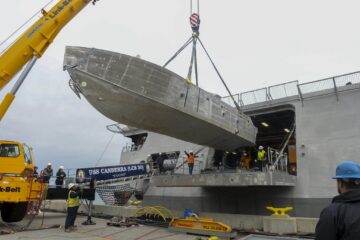A new report released by the German federal audit office (Bundesrechnungshof or BRH) on Thursday, December 7, revealed how the German effort for an MCM-replacement has failed over budgetary and capability conflicts. A costly life-extension for the current fleet and a reset for a new acquisition will be the immediate outcome of that development.
The current German MCM-fleet consists of 10 Type 332 boats, of which two are used to support mine divers. Three Type 332CL “Hohlstablenkboot” command boats are using “Seehund” remote controlled USVs for mine-clearing. The oldest boats commissioned into the fleet in 1993, and the newest ones in 1998, resulting in an age of 25 to 30 years across types. The MCM-fleet has also experienced notable reductions over the last 15 years. Disposal of hulls more than halved the original fleet of over 20 vessels to now 10 boats, primarily over general cost cutting within German defence spending. The remaining boats have seen multiple modernizations to keep them operationally relevant.

Decade-long planning effort featured steadily rising cost estimates.
Planning for a new capability to replace the existing fleet had started in 2014. Germany notably pledged at least 11 modern MCM-vessels with improved capability over the existing fleet to NATO by 2031, as noted in the BRH-report. In this context the report writes about seemingly systemic conflicts between various stakeholders, including the Navy and the Federal Ministry of Defence (BMVg) through its planning and procurement offices particularly over perceived key requirements realizing a replacement.
The original intent in 2014 centered on spending an amount of 2.8 billion Euros on the MCM-successor, with cost representing a Navy-estimate. The boats were to feature modern mine warfare drones, a robust self defence-capability and substantial command and control-facilities, including for multinational and longer range-deployments. As the BRH-report notes, the sum of all capabilities required substantially larger hulls, approaching the size of corvettes according to informed observers consulted by Naval News. The German Navy, also according to the report, notably insisted specifications could be met at the quoted cost within existing size parameters.

German Navy-requirements clash with set budget and feasibility of integration.
The size of the new design is relevant insofar as the current German MCM concept of operations envisions deployment of crewed platforms within expansive minefields, instead of pursuing a pure stand off-approach where a crewed mothership directs drone-based solutions from a distance. The latter is the chosen approach for the Belgian-Dutch “rMCM” mine warfare recapitalization currently underway, and which France recently joined. An attempt to merge the existing German concept with new requirements appears to have contributed significantly to dramatically rising costs for the overall effort.
By February 2017 the Bundeswehr Planning Office (Planungsamt der Bundeswehr/PlgABw) in a cursory first review estimated a full replacement satisfying Navy-requirements to cost at least 4.4 billion Euros. The PlgABw also recommended moving command & control-capabilities into separate new tender vessels, which are used to support MCM-units and were also due for replacement. In a detailed analysis by 2018 the total cost for the effort meeting all requirements was assessed by PlgABw to have reached 6 billion Euros.
Meanwhile BMVg imposed a cost ceiling for the effort of 3.5 bln Euros. Notably the Ministry did not issue a reduced list of requirements to meet the new budget, while the Navy insisted on the full list of capabilities. By 2021 the overall effort now included consideration of a mixed fleet of old and new vessels, with only six new boats to be purchased to satisfy the budget objective. Defence officials dismissed that proposal over additional cost and burden in infrastructure including training requirements sustaining two very different capabilities.

Uncertain outlook and questions over NATO-obligation.
In 2022 the BMVg finally reduced the overall funding for the effort to only 1.3 billion Euros, an effective administrative acknowledgement that the procurement had failed. The new money is the amount needed to realise a life-extention of ten years for the existing fleet, including modernization within the limits of the now 30 year old boats. A new effort realizing a successor platform is now set to commence by 2025. Considering how the German MCM-replacement has failed, Bundeswehr seems unlikely to meet the aforementioned NATO-requirement and will also fail to come true on their own “Zielbild Marine 2035+”-aspirations. Instead the service will now have to make do with up to ten mildly modernised MCM-boats which are now expected to stay in service until 2040, by which date they would be almost 50 years old.






